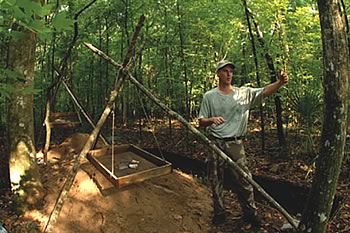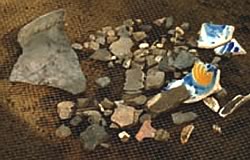Rewind 300 years and imagine you are a Spanish colonist in Florida fleeing for your life to the protection of St. Augustine’s fortified walls. Or maybe you are a Native American desperate to escape the relentless assaults of slave raiders descending from the Carolinas. You pack in haste. You leave most of your bowls, vessels, trade beads and cooking pots, knowing you likely will never return home.

Photo by Jeff Gage
Such was the case in 1706 when the Potano Indians—a sub-group of the Timucua Indians—and Spanish missionaries abandoned their village and the San Francisco de Potano mission, founded in 1606 northwest of Gainesville. Florida Museum of Natural History archaeologists recently unearthed long-sought structural evidence of the mission, under the direction of principal investigator and Florida Museum curator Kathleen Deagan and project archaeologist Gifford Waters.
“This was the first and last of Florida’s interior missions,” Waters said.
For several decades, archaeologists knew from historical records that the site existed. Previous small-scale excavations conducted in the 1950s and 1960s turned up Spanish and Native American pottery, tools and glass trade beads. But structural evidence of the mission had eluded researchers until a pivotal find was uncovered this summer: remnant evidence of Spanish-built posts.
Today, the San Francisco de Potano mission site stretches between a leafy, forested patch of woods and an exposed, modern agricultural field. Waters and his team initially conducted a shovel-test survey on a 25-meter grid to define the site boundaries. Next, they dug test excavation pits in areas the survey revealed to be dense with artifacts.
“We found a lot of trash pits, some with only food refuse like animal parts,” Waters said. “Some had charcoal, which is indicative of cooking.”
The test excavations led Waters to believe they were digging in the Potano village area. But locating Spanish structures associated with the mission was the goal, so researchers reassessed their excavation sites and stumbled upon soil stains indicative of wooden posts, long since rotted.
With diameters at about 30 to 50 centimeters, the posts’ remnant stains were large—much larger than those used in Native American dwellings. The archaeologists believe these represent either the outer walls of the mission’s church, the friar’s house or a school associated with the mission.
“The historical records indicate there was a school, but we don’t know if it was part of the mission church, the friar’s house, or was a separate structure all together,” Waters said.
Waters and his team also uncovered shallow, bowl-shaped clay pads associated with some of the post stains.
“The clay footings surrounding the post molds may have been used to stabilize the posts, or as a means of protection to prevent damage from termites or water,” Waters said.
Use of clay footings in constructing mission structures is known in Florida at only one other site: the Fig Springs Mission in Suwannee County. In several locations, archaeologists uncovered evidence of double-post construction near clay footings.
“What this tells us is that they either built it with two posts for structural reasons, or replaced rotted-out posts side-by-side with newer posts,” Waters said.
The San Francisco de Potano mission was important because it was a “doctrina,” or a regional mission with a resident friar. Smaller missions, known as “visitas” were visited by the friar from the doctrina. Waters said the Spanish method of mission-building was to establish a doctrina in the largest Native American village and then convert the cacique, or chief, which made conversion of the tribe easier.

Photo by Jeff Gage
Historical records indicate the San Francisco de Potano mission was abandoned in 1656 as a result of the Timucua Rebellion, but was reoccupied a few years later after the Spanish quelled the uprising. Waters said the team’s discovery of several types of pottery dating to the mid 1650s provides strong evidence that they found the site of the doctrina, San Francisco de Potano.
“We know from historical documents that the Spanish moved back and reestablished the mission two or three years after fleeing to St. Augustine,” Waters said. “The discovery of Mexican majolica that post-dates 1650 further supports the interpretation that this is the site of San Francisco de Potano and not one of the earlier visitas.”
Numerous turquoise-blue, glass trade beads and a black glass bead, possibly part of a rosary, also peppered their finds.
Waters said the Florida Museum team plans to return for further excavations on what promises to be an important site for deepening our understanding of Spanish Florida’s history and the lives of the Potano Indians.
“The undisturbed state of this site is just remarkable,” Waters said, referring to the area under the forest’s cover. “The research potential is unlimited.”
Learn more about the Historical Archaeology at the Florida Museum.